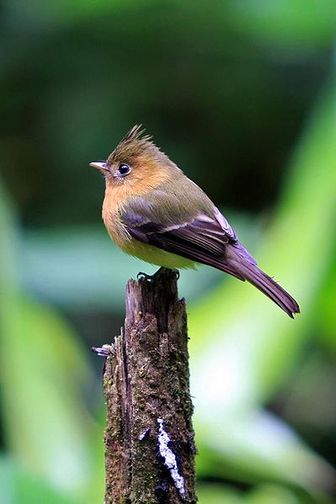Tufted Flycatcher
It is a common inhabitant of mature mountain forest and tall second growth, especially at edges and clearings with trees. It breeds from 700–3000 m altitude, but is most abundant from 1200–2150 m. The female builds a saucer nest of moss, liverworts and lichens 4–27 m high on a branch or vine, usually concealed among ferns, bromeliads and other epiphytes. The female incubates the two brown-blotched white eggs for 15–16 days to hatching,

Original source: Steve RyanPermission(Reusing this file)This image, which was originally posted to Flickr.com, was uploaded to Commons using Flickr upload bot on 22:19, 8 March 2010 (UTC) by Snowmanradio (talk). On that date it was licensed under the license below. This file is licensed under the Creative Commons Attribution-Share Alike 2.0 Generic license.You are free:to share – to copy, distribute and transmit the work
Author: Steve RyanPermission(Reusing this file)This image, which was originally posted to Flickr.com, was uploaded to Commons using Flickr upload bot on 22:19, 8 March 2010 (UTC) by Snowmanradio (talk). On that date it was licensed under the license below. This file is licensed under the Creative Commons Attribution-Share Alike 2.0 Generic license.You are free:to share – to copy, distribute and transmit the work
The Tufted Flycatcher is classified as Least Concern. Does not qualify for a more at risk category. Widespread and abundant taxa are included in this category.
English: Common Tufted Flycatcher, Common Tufted-Flycatcher, Northern Tufted Flycatcher, Northern Tufted-Flycatcher, Tufted Flycatcher, Tufted fycatcher Spanish: Atrapamoscas Moñudo, Mosquerito Moñudo, Mosquero Copetón, Mosquero crestado, Mosquero Moñudo Común, Mosquero Penachudo, Mosquitero Moñudo Spanish (Colombia): Atrapamoscas Moñudo Spanish (Costa Rica): Mosquerito moñudo Spanish (Honduras): Mosquero crestado Spanish (Mexico): mosquero copetón, Mosquero Penachudo Spanish (Nicaragua): Mosquitero Moñudo Finnish: Töyhtösieppari French: Moucherolle huppé Italian: Pigliamosche dal ciuffo More
Discovery: First Occurrence of Tufted Flycatcher in Arizona Mark M. Stevenson Steven and Julie Servantez were visiting Las Vegas to attend a veterinary conference. Being from Wisconsin and being amateur birders interested in photography, they were looking for opportunities to experience western birds, particularly the Burrowing Owl. At the Lake Meade National Recreation Area information center they asked about the owls. More
A Mexican species, Tufted Flycatcher, Mitrephanes phaeocercus, was discovered on 5 May, in Arizona's Chiricahua Mountains by Daniele Mitchell from Canada. Today, 6 May, the Tufted Flycatcher was being seen in Cave Creek Canyon at the Herb Martyr Campground, part of Coronado National Forest. Tufted Flycatcher was first found in the U.S. in Rio Grande Village, a part Big Bend National Park, Texas, from 3 November '91 - 17 January '92. More
The Northern Tufted Flycatcher, Mitrephanes phaeocercus, is a small passerine bird in the tyrant flycatcher family. It breeds in highlands from northwestern Mexico to northwestern Ecuador. The Olive Flycatcher (Mitrephanes olivaceus) of Peru and Bolivia is now considered a separate species. It is a common inhabitant of mature mountain forest and tall second growth, especially at edges and clearings with trees. It breeds from 700–3000 m altitude, but is most abundant from 1200–2150 m. More
The Olive Tufted Flycatcher (Mitrephanes olivaceus) is a species of bird in the Tyrannidae family. It is found in Bolivia and Peru. Its natural habitat is subtropical or tropical moist montanes. References - * BirdLife International 2004. Mitrephanes olivaceus. 2006 IUCN Red List of Threatened Species. Downloaded on 26 July 2007. Stub icon This article about a tyrant flycatcher is a stub. More
This Tufted Flycatcher was photographed and recorded at the Herb Martyr Campground, in the Chiricahua Mountains on May 6, 2008. This bird was first found the previous day by Daniele Mitchell, and Rick and Matthew Johnson. See this article for the status of this species in Arizona and the United States. Photo and recording © Chris D. Benesh. More
This Tufted Flycatcher (Mitrephanes phaeocercus) was discovered at Big Bend National Park in Brewster Co., Texas on 3 November 1991. It was the first time the species had been recorded in the United States. The Tufted Flycatcher inhabits mountain evergreen and pine-oak woodlands in Mexico and occurs as far south as Bolivia. It is a small flycatcher, similar in size to the Empidonax flycatchers, with a spiky crest. This bird stayed at Big Bend until 17 January 1992 and was seen by many birders. More
cooperative is a Tufted Flycatcher, working its own swarm of gnats a few hundred meters up the trail. Tufted Flycatcher (46780 bytes) 16 March 2002 Each day I hear the hoarse calls of Tufted Jays, and catch glimpses of them through the vegetation. They are quite handsome, clad in white with black breast and face, bold crest, and navy blue wings. The range of Tufted Jay is so small that they were unknown to science until the 1930s. More
Vegas photographed digitally one of two Tufted Flycatchers that were on the Arizona side of Lake Mojave, where White Rock Canyon empties into the lake. This is between Hoover Dam and Willow Beach. On Friday they appeared at the visitor center at Henderson Bird Viewing Preserve and showed their pictures to staff who identified the bird. .... Today, ... hiked down to the site and spent about two hours, from 9-11 a.m. More
IMG_2091 Tufted Flycatcher Tufted-Flycatcher (Common or Northern) Locations for recordings with GPS coordinates (ranges from Infonatura) Resultados 1 - 5 de 5 de 1 especies for sp:2508.00 (solo especies en primer plano). More
Family : Tyrannidae
Genus : Mitrephanes
Species : phaeocercus
Authority : (Sclater, 1859)
